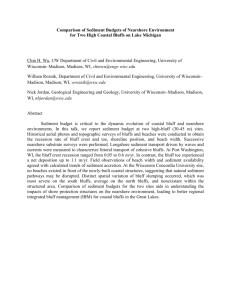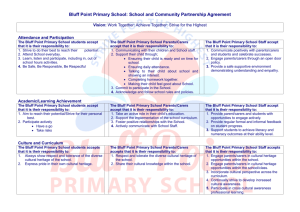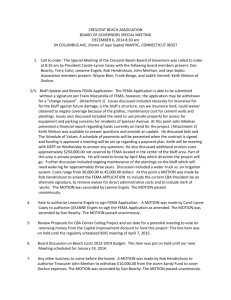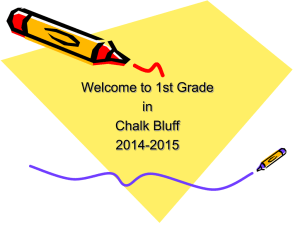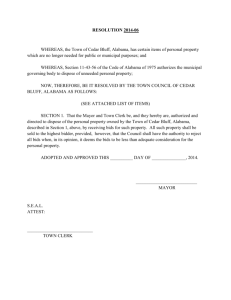Coastal Property Owner Hazard Guide
advertisement
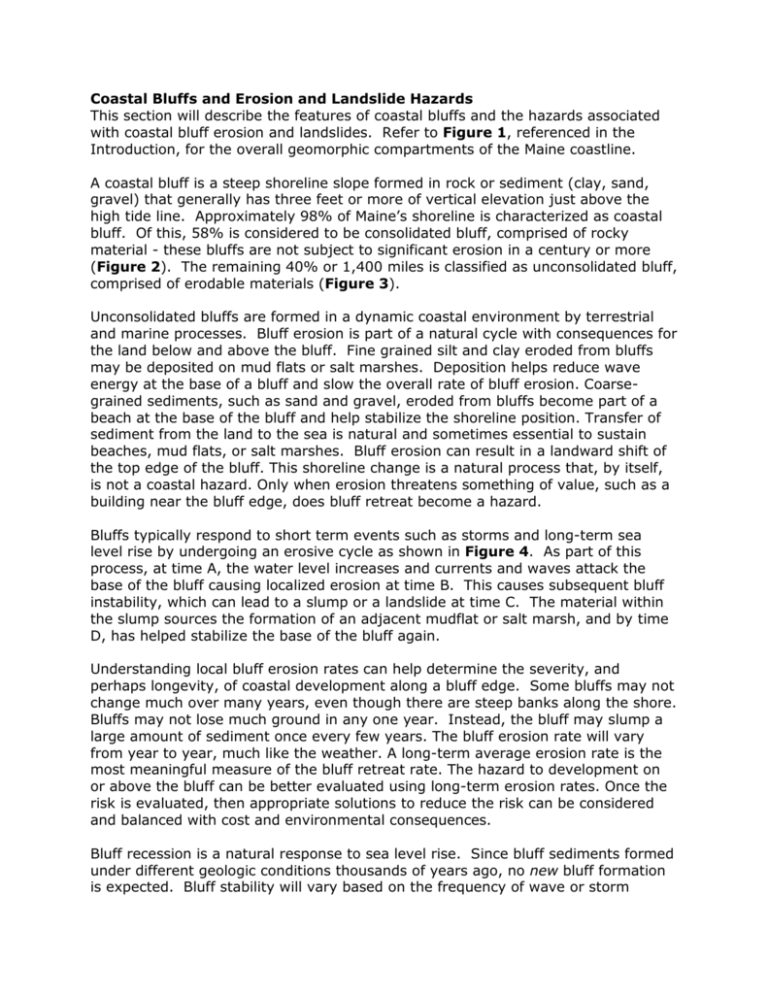
Coastal Bluffs and Erosion and Landslide Hazards This section will describe the features of coastal bluffs and the hazards associated with coastal bluff erosion and landslides. Refer to Figure 1, referenced in the Introduction, for the overall geomorphic compartments of the Maine coastline. A coastal bluff is a steep shoreline slope formed in rock or sediment (clay, sand, gravel) that generally has three feet or more of vertical elevation just above the high tide line. Approximately 98% of Maine’s shoreline is characterized as coastal bluff. Of this, 58% is considered to be consolidated bluff, comprised of rocky material - these bluffs are not subject to significant erosion in a century or more (Figure 2). The remaining 40% or 1,400 miles is classified as unconsolidated bluff, comprised of erodable materials (Figure 3). Unconsolidated bluffs are formed in a dynamic coastal environment by terrestrial and marine processes. Bluff erosion is part of a natural cycle with consequences for the land below and above the bluff. Fine grained silt and clay eroded from bluffs may be deposited on mud flats or salt marshes. Deposition helps reduce wave energy at the base of a bluff and slow the overall rate of bluff erosion. Coarsegrained sediments, such as sand and gravel, eroded from bluffs become part of a beach at the base of the bluff and help stabilize the shoreline position. Transfer of sediment from the land to the sea is natural and sometimes essential to sustain beaches, mud flats, or salt marshes. Bluff erosion can result in a landward shift of the top edge of the bluff. This shoreline change is a natural process that, by itself, is not a coastal hazard. Only when erosion threatens something of value, such as a building near the bluff edge, does bluff retreat become a hazard. Bluffs typically respond to short term events such as storms and long-term sea level rise by undergoing an erosive cycle as shown in Figure 4. As part of this process, at time A, the water level increases and currents and waves attack the base of the bluff causing localized erosion at time B. This causes subsequent bluff instability, which can lead to a slump or a landslide at time C. The material within the slump sources the formation of an adjacent mudflat or salt marsh, and by time D, has helped stabilize the base of the bluff again. Understanding local bluff erosion rates can help determine the severity, and perhaps longevity, of coastal development along a bluff edge. Some bluffs may not change much over many years, even though there are steep banks along the shore. Bluffs may not lose much ground in any one year. Instead, the bluff may slump a large amount of sediment once every few years. The bluff erosion rate will vary from year to year, much like the weather. A long-term average erosion rate is the most meaningful measure of the bluff retreat rate. The hazard to development on or above the bluff can be better evaluated using long-term erosion rates. Once the risk is evaluated, then appropriate solutions to reduce the risk can be considered and balanced with cost and environmental consequences. Bluff recession is a natural response to sea level rise. Since bluff sediments formed under different geologic conditions thousands of years ago, no new bluff formation is expected. Bluff stability will vary based on the frequency of wave or storm attack, the inundation of the bluff to coastal flooding, and the ability of the bluff to shed sediment at a rate that would remain to form a protective wetland or marsh in front of it. It is likely that these features will continue to erode and move landward due to rising sea levels. Identification of Eroding Coastal Bluffs and Landslides To aid individuals in identifying and characterizing the stability of coastal bluffs, MGS has produced a map series called Coastal Bluff Maps. MGS also created Landslide Hazard Maps that describe the internal stability of sediment bluffs. The companion Coastal Bluff Maps describes the processes and stability of the face of a bluff. These maps provide additional information about the slope, shape, and amount of vegetation covering a coastal bluff and the adjacent shoreline. These factors are directly related to the susceptibility of the bluff face to ongoing erosion and subsequent formation of landslides. Additional map series available from the MGS show topography, sediment composition, ground-water characteristics, and bedrock geology – factors which influence the stability of a bluff or potential for landslides to occur. Some specific map titles are available online at the MGS website, others are available in print format at the MGS office. MGS geologists are available to explain these maps. Features of Coastal Bluff Erosion In the field, there are numerous features an individual can look at in determining the overall stability of an unconsolidated bluff. Generally, the sediments, slope, shape, and amount of vegetation covering a coastal bluff and the adjacent shoreline are directly related to the susceptibility of the bluff face to ongoing erosion. Unconsolidated bluffs can be categorized as being highly unstable, unstable, or stable. Highly Unstable Bluff: Near vertical or very steep bluff with little vegetation and common exposure of unstable bare sediment. Fallen trees and displaced blocks of sediment are common on the bluff face and at the base of the bluff. Examples of different kinds of highly unstable bluffs are provided in Figures 3 and 5. Unstable Bluff: Steep to gently sloping bluff mostly covered by shrubs with a few bare spots. Bent and tilting trees may be present. Two examples of unstable bluffs are shown in Figures 6 and 7. Stable Bluff: Gently sloping bluff with continuous cover of grass, shrubs or mature trees. Relatively wide zone of ledge or sediment occurs at the base of the bluff. This category implies stability in the short-term based on observations at the time of mapping. Over time, stable bluffs can become unstable to cyclic changes (described above) or destabilizing natural or human events. Several examples of stable bluffs are shown in Figures 8 and 9. Features of Landslides Due to the inherent connection between coastal bluffs and landslides, one of the biggest hazards associated with coastal bluffs is the threat of landslides. Landslides are the rapid movement of earth materials downslope under the force of gravity. Many landslides have occurred along the Maine coast in the last few centuries, and more landslides will happen in the future. Based on history and field evidence, a variety of scenarios and possible events, from large to small and fast to slow, can threaten property and, in a few cases, put human life at risk. It is not possible to predict exactly when and how large the next coastal landslide will be. Landslides have occurred frequently enough that geologic analysis and informed land use can lead to risk reduction and improved emergency response. Landslides can occur in high coastal bluffs composed of muddy sediment. Landslides have generally been classified into several different types, as shown in Figure 10: Slides: The general term “landslide” is used to describe many types of earth movements, but in formal terms landslide should be used to refer only to mass movements, where there is a distinct zone of weakness that separates the displaced material from more stable underlying material. Rotational slide (A in Figure 10). This is a slide in which the surface of rupture is curved concavely upward and the slide movement is roughly rotational. Translational slide (B). In this type of slide, the landslide mass moves along a roughly planar surface with little rotation or backward tilting. Rockfalls: (D). Rockfalls are abrupt movements of masses of geologic materials, such as rocks and boulders, that become detached from steep slopes or cliffs. Flows: earth movements where the mass movement is not primarily along a defined zone of weakness. Flows include both rapid mass movements and slow mass movements. Debris flow (F). A debris flow is a form of rapid mass movement in which a combination of loose soil, rock, organic matter, and water mobilize as a slurry that flows downslope. Earthflow (H). An earthflow is a downslope viscous flow of fine-grained materials that have been saturated with water, and move under the pull of gravity. Creep (I). Creep is the imperceptibly slow, steady, downward movement of slopeforming soil or rock. Movement is caused by shear stress sufficient to cause permanent deformation, but too small to cause shear failure. NOTE: Descriptions taken from USGS (2004). Factors influencing Coastal Bluff Erosion and Landslides There are numerous, interconnected factors that influence the overall stability of a bluff, bluff erosion, and the formation of landslides. Understanding these factors and looking for certain telltale characteristics associated with those factors can help you better understand the stability of your bluff. Some of these features are illustrated in Figure 11. Since landslides typically occur on unstable coastal bluffs, the factors influencing their formation are much the same. Certain specific factors should be evaluated by a homeowner when determining the landslide susceptibility of an existing site (most are the same as for coastal bluffs). The information provided below has been developed from text used for the MGS Landslide Hazard Maps, and information found at the State of Washington Department of Ecology website. Height. The height of an unconsolidated bluff can be indicative of its overall stability and potential landslide risk, especially when taken into account with other factors. While sediment strength depends on several factors, the thicker the sediment deposit, the more likely its weight will cause subsurface movement or slippage that leads to a landslide. The risk of an unstable coastal bluff or landslide increases when mud bluffs have a height of twenty feet or more. In general, the higher the exposed bluff face the greater the risk of slope failure and a landslide. Sediment type. The soils that form a coastal bluff are important in determining the potential for overall bluff failure and stability. Along the Maine coastline, underlying soils typically include bedrock, glacial till, gravel and sand, or clay. As discussed previously, bluffs comprised of bedrock are eroding slowly, and their associated hazard is relatively low. Many unconsolidated bluffs in Maine are comprised of a combination of materials. Clay and silt (muddy) sediment is the most unstable material that can make up a bluff. These fine-grained sediments are weak and prone to moving in the form of slow-motion creep, moderate-sized slumping, or large landslides. Many bluffs are underlain with a gray glaciomarine clay known as the Presumpscot Formation. Sand and gravel deposits tend to be stronger and better drained than muddy sediment. Landslides can occur in coarse-grained bluffs although they are less frequent than muddy landslides along the Maine coast. Crystalline rock or ledge is much more stable than any sediment bluff and not likely to erode or slide. The elevation of bedrock at the shore and inland beneath a bluff is important in determining landslide risk. Bedrock exposures along the shoreline may slow erosion and make sediment less susceptible to landsliding. Beneath a sediment bluff, bedrock may rise toward the surface and reduce the overall thickness of sediment and thus reduce the risk of deep-seated movement below the ground surface. Slope. Coastal bluffs have a relatively steep ocean-facing slope. The angle of a bluff face varies due to factors such as the sediment type and rate of erosion at the base of the bluff. Slope is also affected by the history of slumps and landslides at the site. Some slopes are uniformly straight while others are terraced or uneven due to prior earth movements. In general, the steeper the slope, the easier it is for gravity to initiate a landslide. Concave surface topography will tend to concentrate the flow of surface water and ground water, raising ground-water pore pressures and reducing the shear strength of the soil. As a result, concave slopes are more susceptible to failure than straight slopes or convex slopes. The most accurate way to determine the slope is to purchase an inclinometer or clinometer. One can also construct a home-made clinometer using a protractor, string, and a yardstick. The protractor is fastened securely to a yardstick with a string and weight attached as shown in Figure 12. When the yardstick is held up and aligned with what appears to be the average slope of the land, the slope angle can be read directly from the protractor. This slope angle can then be converted to the appropriate horizontal/vertical ratio, if needed. The quickest but least accurate way to estimate slope height is to visually estimate the height of some nearby vertical structure on the slope (i.e. tree or bluff face) and then estimate how many tree heights would equal the overall slope height. Slope aspect: Slope aspect is the direction toward which the surface of the soil faces. South-facing slopes undergo more extensive freeze/thaw cycles in winter months than slopes with other aspects. Repeated freeze-thaw cycles preferentially reduce the shear strength of the shallow soil material and increase the likelihood of shallow soil slumps. Ultimately, small movements may steepen the slope and lead to larger slope failures. Topography. The presence of swales, gullies, or drainage channels on or adjacent to a shore site can affect surface water movement. These features can direct surface water flow towards or away from the bluff face and slope. They also affect the recharge of sub-surface water and groundwater. The sometimes steep sides of such features can concentrate and accelerate runoff, increasing surface erosion. These features often indicate the site of past erosion or landslides. Modifications of existing topography should not be undertaken lightly. Vegetation. Types, shapes, and distribution of vegetation above and on a bluff face can be used as an indication of site stability. The type, age, health, and abundance of vegetation growing on a shoreline bluff site can offer valuable clues to determine slope stability. Even the presence of stumps and fallen trees can tell a story to a knowledgeable observer. This section discusses these clues and what they may indicate. Vegetative indicators are best interpreted in combination with soil and geological data. In areas where the soil has shifted, either due to previous landslides or to gradual surface creep, many tree trunks can become tilted or twisted in the same direction. Curved tree trunks near the roots often indicate land movement down the face of a bluff. Trees that appear to be jumbled in groups on slump blocks that have slid down a slope are called jackstrawed trees. Evidence of jackstrawed trees usually indicates that a groundwater problem or slope instability exists, which caused the mass of soil and associated vegetation to move downslope as a single unit or block. Distinct lines of trees growing across a slope may indicate one of two different conditions. If the trees are young, fast growing species (e.g., such as red alder or willow), a previous landslide may have occurred, and opportunistic, fast growing species have colonized the slide site. The age of trees growing in this manner can be a clue to when the slide occurred. A distinct line of trees of a similar species that are water loving (“hydrophilic”) may also indicate an area of perched water or groundwater seepage that in turn may indicate a layer of impervious material underlying a deposit of sandy soil. The presence of such trees may indicate site instability, and should be investigated geologically. Microclimate and Aspect. The weather along Maine’s diversely shaped coastline is strongly influenced by changing topographic and atmospheric conditions. The degree of precipitation, available sunlight, temperatures, and wind can change radically from one section of coastline to another along the numerous bays, rivers, and headlands found along the coast. The factors of microclimate and aspect (which direction your bluff faces) should be recognized in your site evaluations and planning effort which includes both planting and drainage control elements. Waves, tides, and sea level. Several marine processes affect the risk of landslides along a coastal bluff. A gradual, but ongoing rise in sea level at a rate of about an inch per decade is causing chronic erosion along the base of many bluffs. As sea level rises, wave action and coastal flooding can reach higher and farther inland and scour more sediment from a bluff. Sea ice erodes tidal flats and the base of bluffs by abrasion and freezing sediment in ice blocks. Erosion can increase the steepness of a bluff slope and make it more susceptible to landsliding. Tides are also important in washing away eroded bluff sediment which helps wave action move inland. Storms that create wind, waves, and flooding can cause more extreme erosion at the base of a bluff, increase the bluff slope, and make a landslide more likely. Drainage. Water located in and on a coastal bluff can be the most common factor that causes bluff instability. Drainage can occur as groundwater seepage within a bluff, or surface runoff on the bluff itself. As such, observations of drainage factors are sometimes best made during or directly after periods of heavy rainfall, when surface runoff and groundwater discharge are at their peak. Water tables, and hence discharge, tend to be highest in spring as the ground thaws (Ground Water Handbook for the State of Maine, Caswell (1987)). Surface water. The amount, type, and location of surface water can influence bluff slope stability and may contribute to erosion and landslides. Wetlands, ponds, and streams above the bluff can supply water to the bluff face and also to the ground water. The elevation or topography of the land surface determines which way surface water will flow. Water that runs over the face of a bluff can wash sediment to sea, increase the bluff face slope, and weaken the remaining sediment holding up the bluff. Removal of sediment from the bluff face can increase the risk of erosion or a landslide. Direct rainfall to a bluff is sometimes the deciding factor influencing bluff stability. However, wind and frost wedging do act upon some exposed slopes. When identifying drainage issues, look for the many features listed in this section – they are usually associated with drainage problems along a bluff (i.e., vegetation types, formation, soil types, and geology). Ground water. Ground water inland of a bluff comes from surface sources, such as rain or a stream, uphill in the local watershed. Ground water tends to flow horizontally beneath the surface and may seep out the face of a bluff. Seeps and springs on the bluff face contribute to surface water flow and destabilize the bluff face. In addition, a high water table can saturate and weaken muddy sediment and make the ground more prone to slope failure. Weathering. Weathering in clay and silt can change the strength of bluff sediment and stability of the bluff face. Drying of clay can increase resistance to sliding. The seasonal cycle of freezing and thawing of the bluff face can lead to slumping after a thaw. Earthquakes. Landslides can be triggered by earthquakes. Ground vibration loosens sediment enough to reduce the strength of material supporting a bluff and a landslide results. Most landslides triggered by earthquakes in sediment like that found in Maine have been of Richter magnitude 5 or more. These are relatively rare events, but a few have occurred in historical time in Maritime Canada. Land use. Human activity and land use may contribute to or reduce the risk of a landslide. Actions that increase surface water flow to a bluff face, watering lawns or grading slopes, add to natural processes destabilizing the bluff face. Surface water, collected by roofs, driveways, paths, and lawns flows toward and down the bluff face. Walkways down the face of a bluff can lead to greater erosion from foot traffic or the concentration of surface water flow. Elevated stairs can shade the slope and prevent vegetation from stabilizing the slope. Both surface and ground water above a bluff can be supplied by pipes, culverts, surface drains, and septic systems. Increased water below ground can weaken a bluff and contribute to internal weakness that leads to a landslide. Greater seepage of water out of the bluff face can also increase the risk. Clearing of vegetation from the bluff face can lead to greater bluff erosion and a steeper bluff that is more prone to landslide. Vegetation tends to remove ground water, strengthen soil with roots, and lessen the impact of heavy rain on the bluff face. NOTE: Removal of vegetation within a shoreland zone increase the quality of a view may require a permit from the Maine DEP and/or your local town. Adding weight to the top of a bluff can increase the risk of a landslide. Buildings, landscaping, or fill on the top of the bluff can increase the forces that result in a landslide. Saturating the ground with water that raises the water table also adds weight. Even ground vibration, such as well drilling or deep excavation, may locally increase the risk of a landslide. Shoreline engineering in the form of seawalls, rip rap, or other solid structures is sometimes used to reduce wave erosion at the toe of a bluff. In some settings, engineering can increase the rate of beach or tidal flat erosion and lower the shore profile over time. This intertidal erosion can undermine engineering and result in less physical support of the base of the bluff by natural sediment. When coastal engineering ends along a shoreline, “end effect” erosion can cause worse erosion on adjacent properties. Engineering alone cannot prevent some large landslides. In general, human activities that increase the amount or rate of natural processes may, in various ways, contribute to landslide risk. This Guide includes a Coastal Property Owner: Bluff and Landslide Checklist which outlines some of the key features to look for in assessing problems associated with bluff stability and landslide hazard. This checklist will allow you to organize your site observations, and help you determine the overall stability of bluffs on your property. We recommend that you use this checklist for general purposes only, and advise consultation with appropriate experts, such as licensed engineers or certified geologists. Regulations Applicable to Activities on or near Coastal Bluffs There are many local and state regulations that apply to activities on or adjacent to coastal bluffs relating to erosion and landslides. To help guide property owners, the Maine DEP has released A Homeowner’s Guide to Environmental Laws Affecting Shorefront Property in Maine’s Organized Towns (Maine DEP, 2000). A general summary of applicable regulations to activities at Coastal Bluffs and Landslides are listed below. Erosion and Sediment Control Law The Erosion and Sediment Control Law erosion control provision is a very brief and basic standard requiring that a person who conducts an activity involving filling, displacing or exposing earthen materials take measures to prevent unreasonable erosion of soil or sediment beyond the project site or into a protected natural resource. Shoreland Zoning Ordinance. By law, Maine communities adjacent to the ocean, lakes, rivers, some streams and wetlands, are subject to regulation under the Mandatory Shoreland Zoning Act. Generally, areas within 250 of one of the normal high water line are within the Shoreland Zone and subject to a community’s Shoreland Zoning Ordinance. Shoreland Zoning creates different types of districts within which you might be located that regulate certain activities within those districts, based on the presence of specific resources and uses. It is also used to establish certain setbacks from resources. The Maine DEP has released a Citizen’s Guide to Shoreland Zoning which helps explain zoning districts and regulations. Also note that vegetation removal within the Shoreland Zone is limited and may require a permit. Consult your local Town Code Enforcement or Planning Department to determine the specific regulations within your Municipal Shoreland Zone. Maine Natural Areas Protection Act (NRPA). This includes Permit-by-Rule (PBR, permitting for de minimus activities), and full Individual Permits for certain activities. Activities within 75 feet of the Highest Annual Tide will require an NRPA permit. Activities within 25 feet of the HAT cannot be permitted with a PBR. Any coastal rip-rap stabilization will require a full NRPA permit. Water Quality Certification. An applicant for a federal license or permit to conduct an activity that may result in a discharge to a navigable water of the United States must supply the federal licensing authority with a water quality certification from the State that any such discharge will comply with State water quality standards. The federal license or permit may not be issued until water quality certification has been issued or waived. Federal Clean Waters Act and Rivers and Harbors Act Sections of the federal Clean Water Act and Rivers and Harbors Act govern activities within coastal wetlands (and therefore waters associated with bluffs) and tidal creeks and adjacent rivers. Permits are administered by both the US Army Corps of Engineers (US ACE) and the US Environmental Protection Agency (US EPA). Federal permitting includes comments provided by the US Fish and Wildlife Service and National Marine Fisheries Service. Text supporting both of these Acts can be seen at the Wetlands Regulation Center. Section 10 of the Rivers and Harbors Act requires a US ACE permit for any work in navigable (tidal) waters below the mean high water line. Section 404 of the Clean Water Act requires a US ACE permit for the discharge of dredged or fill material into waters of the US. The US EPA maintains good information describing the overall laws and applicable regulations that pertain to federal permitting of activities within waters of the United States. What are my Adaptation Options? The steps below summarize how coastal property owners can go about addressing problems associated with eroding coastal bluffs or landslide hazards. 1. 2. 3. 4. 5. 6. 7. Identify the Hazard(s). Classify the Level of Risk. Determine if the hazard(s) identified can be mitigated. Determine if the risks associated with known hazards are acceptable. Determine setback standards. Get appropriate permits. Appropriately adapt to or mitigate the hazard. i. Doing nothing. ii. Avoid the hazardous area. iii. Relocate existing infrastructure. iv. Design and build properly. v. Plant erosion-resistant vegetation. vi. Divert water flow. vii. Change the slope of the land surface. viii. Stabilize the eroding slope. 1. Identify the Hazard(s). One of the first things that an individual can do in determining bluff hazards for their property is to identify your hazard by using the numerous resources listed above in conjunction with doing a field inventory of your property. Some of these “in the field” signs are outlined in the sections above and summarized in the Coastal Property Owner: Bluff and Landslide Checklist. Use available resources, including but not limited to the MGS series of maps, and additional applicable information, to preliminarily determine the stability of your bluff and the potential landslide hazard. 2. Classify the Level of Risk. Once you have determined the presence or absence of hazards at your property, the next step is to classify the level of risk associated with each hazard. That is, if bluff erosion is occurring, at what rate in the short term? What is the long-term erosion rate? How close is your structure to the high water line? Use the Coastal Property Owner: Bluff and Landslide Checklist to help determine the level of hazard posed to your bluff property. Especially in areas of high erosion and instability, it is recommended that you have a professional geologist or licensed geotechnical engineer investigate your property to help you further classify the risk. 3. Determine if the hazard(s) identified can be mitigated. In conjunction with your professional(s), determine what hazards can expectantly be mitigated, and at what cost. For example, if you have identified an existing bluff erosion hazard, can you locate your structure so that it is well outside an expected future erosion line? As part of this process, remember some of the goals, priorities, and expectations of the use of your property in conjunction with risk. Be realistic. It may not be technologically or economically feasible to stabilize certain types of slopes. Be neighborly. Think about potential impacts on your neighbor’s property that may result from an activity on your property. At the same time, it may make sense to work with adjacent property owners if a common goal is found or regional approach is being adopted. Consider the costs. When comparing strategies, consider the short and long-term costs of different strategies. Consider the permit requirements. Make sure to fully assess the local, state and federal permitting requirements – and their associated timeframes and costs. Consider timeframes. Some activities or strategies may have extended permit review processes, certain habitat types or timing restrictions, and extended construction timeframes. Also think about the timeframe of expected usage of your property. 4. Determine if the risks associated with known hazards are acceptable. Taking into account the information that you developed in terms of mitigation as part of #3, determine the level of risk you are willing to accept to meet your goals, priorities, and expectations relating to the use of your property. For example, if you identified a bluff erosion or landslide hazard, are you willing to accept the risk associated with potential damage or loss of the structure in 5 years? 10 years? 15 years? 5. Determine setback standards. If contemplating new construction, determine minimum appropriate setbacks based on your Municipal Shoreland Zoning Ordinance, other ordinances, and applicable state and federal rules. You may be required to not only set the structure back a certain distance, but to limit its overall size, or use certain types of setback construction techniques. Check with your local Code Enforcement Officer for specific information relating to setbacks and elevation standards. 6. Get appropriate permits. Building or engineering on Maine's slopes and bluffs, especially along waterways or in coastal areas, is likely subject to regulation under the Natural Resources Protection Act and the Mandatory Shoreland Zoning Act. Permits from the Maine Department of Environmental Protection may be required for site modifications. Permits from the Maine DEP and your town may be required. Local Code Enforcement Officers, in addition to consultants and engineers, should be able to give advice on local and state requirements for permits based on the activities you may be proposing on your property. Maine DEP is available for a pre-application meeting to explain the state standards. 7. Appropriately adapt to or mitigate the hazard. To manage or reduce the risk of bluff erosion or landslide hazards impacting your property, there are certain activities that may can be undertaken (these may require permits). These should be developed in conjunction with the steps involved above, and input from appropriate local experts (certified geologists, licensed geotechnical engineers, landscape architects, etc.). Mitigating a hazard or hazards sometimes may need to involve groups of coastal property owners to be most effective (e.g., bluff stabilization through plantings or construction or dewatering efforts). The mitigation and adaptation strategies listed below can be undertaken one-at-a-time, or using a multi-strategy approach that is most applicable to your case. From an environmental impact standpoint, MGS generally recommends that alternatives be considered in the order listed. However, in many cases a combination of several or all of the listed alternatives can and should be considered in order to create a resilient coastal property. Appropriate mitigation strategies should be developed in conjunction with appropriate local experts. To aid with development of appropriate mitigation alternatives, a guide to Maine Erosion and Sediment Control Best Management Practices, which contains techniques applicable to coastal bluff and landslide sites, has been developed by the Maine DEP. In support of this section on mitigating Coastal Bluffs and Landslides, specific attention should be given to supporting document links relating to: Land Grading and Slope Protection Permanent Vegetation Geotextiles Riprap Slope Stabilization Gabions Water Diversion Streambank Stabilization Note that many of the techniques summarized may require permitting from the Maine DEP. Doing nothing. In some cases, the “do nothing” alternative makes the most sense. If there is no structure on an eroding bluff, or if a structure is located a more than adequate distance from an eroding bluff or landslide site, and the bluff has a well determined and steady erosion rate (this should be determined in consultation with local experts), a coastal property owners can opt to do nothing. Doing nothing is also sometimes considered a last alternative – after other, more expensive and intensive options have been undertaken with no success. Doing nothing is typically a least-costly alternative and does not require permitting, unless erosion causes damage to property or infrastructure. The do nothing alternative must take into account the level of risk you are willing to accept in conjunction with the expected uses of your property. Coastal property owners located along eroding bluffs or near landslide prone areas should check their insurance policies relating to coverage. Avoid the hazardous area. In a general sense, avoiding existing or potential hazards as much as possible is usually the most efficient and cost effective method of mitigation. This alternative is especially effective for the siting of new development. Choosing to avoid some areas and not others should be based on the hazards identified, their levels, mitigation strategies, and the level of risk you are willing to accept. A common avoidance technique is to build a structure far landward as possible. You may need to request a variance from local setback ordinances in order to do so. As much as is practicable with your building considerations, consider moving back to avoid some hazards. Consideration should also be given to significant habitat resources or environmentally sensitive areas, which are usually identified by Shoreland Zoning or State regulations. However, it is not always practicable for existing development to avoid all hazards or habitats due to the location of a structure, presence of setbacks, lot size, cost, or other factors. Relocate existing infrastructure. In the case of existing development that is being threatened by bluff erosion or landslides, one of the most effective ways to ensure safety of a structure is to relocate the structure out of the hazardous area, typically in a landward direction. Although this method can be very effective in minimizing or mitigating the hazard, this alternative can be quite expensive. Costs can be quite variable (ranging from several thousand to tens of thousands of dollars) and are based on the existing foundation of the structure, size of the structure, topography, and distance the structure may need to be moved. Consultation with a local contractor is suggested, and local and State permits may be needed. Relocation of a structure can also be constrained by the size of a property and any applicable local or State setbacks, such as from other existing structures or roadways. In many cases, variances from local setback ordinances can be requested by a homeowner so that relocation may be undertaken. Design and build properly. For construction on or directly adjacent to coastal bluffs, it is vital to follow proper construction techniques. This involves not only construction siting (i.e., structure and support structures, including septic, utilities, etc.), but also design and building techniques that can withstand hazards and potential land, wind and water forces associated with this dynamic coastal zone. Consideration should be given to the following: Construction footprint in the face of applicable setbacks for hazards or sensitive areas; The extent of grading to achieve a stable building footprint; The level of engineering required to mitigate for hazards; Potential hydrostatic and wind loading; Water diversion; Siting of ancillary infrastructure; and General construction standards. Some of the best and most comprehensive resources available to the general public regarding proper coastal construction techniques are the FEMA Coastal Construction Manual and the FEMA Home Builder’s Guide to Coastal Construction Technical Fact Sheets. The Construction Manual is available as a CD or in print copy by calling FEMA Publications Distribution Facility at 1-800-480-2520, and should also be available for review at your local town office or public library. Lot coverage requirements and building restrictions for different bluff areas may exist in Municipal Shoreland Zoning Ordinances or other local regulations. Plant erosion-resistant vegetation. Stabilization of mildly eroding bluffs can be achieved through specific bluff planting techniques. The Washington Department of Ecology has provided a great guide on vegetative planting techniques. Many of the techniques are applicable to Maine, though species will be different. The University of Maine Cooperative Extension has compiled a listing of native plant species in Maine, and a listing of nurseries and garden centers. The Maine Natural Areas Program has created a book Natural Landscapes of Maine: A Guide to Natural Communities and Ecosystems that can generally be used to provide guidance on existing dominant vegetative species in different landscapes in Maine. MNAP also maintains a database of plant communities located at coastal headlands which can be used as general guidance for applicable species. The Barnstable County, Massachusetts Cooperative Extension maintains a list of trees and shrubs for coastal environments. For additional information on appropriate vegetation species and techniques in Maine, consult with local landscape architects. For the specific strategies listed below, we recommend consultation with a licensed geotechnical engineer and/or a professional geologist to determine which of these method(s) might be most applicable to and effective for an individual property. Divert water flow. In many cases, providing adequate drainage for a bluff face can be a key factor on the stability of a bluff. Water drainage can be maintained through installation of surface and subsurface drainage devices within and adjacent to potentially unstable slopes. Surface and subsurface drainage design must include consideration of the effects of surface runoff and groundwater migration on the stability and water quality of adjacent sites. Surface contours can be designed to drain surface water on a site away from a bluff – this can substantially reduce infiltration and groundwater adjacent to a bluff face. Some examples of techniques used for controlling surface and subsurface drainage along bluffs are well summarized in work done by the California Coastal Commission. Change the slope of the land surface. This can include reducing the overall slope or overhangs by grading the bluff to a lower angle. Decreasing the slope of a bluff will generally decrease the erosion and landslide hazard. Some slopes can be stabilized by terraces. Stabilize the eroding slope. In locations where other strategies cannot be implemented, bluff stabilization could be considered. Many different stabilization techniques can be applied to an eroding bluff. Techniques can include stabilization solely at the base of the eroding bluff, or stabilization of the entire bluff surface using a single technique or combination of tree rafts, wattles, geotextile fabrics, riprap, or gabion structures. The costs associated with bluff stabilization can be quite high dependent upon the size and project design specifications. Permitting may be required for not only the actual activity, but also for staging or seasonal use of equipment, especially if it occurs from the seaward side of the project and is within the “coastal wetland” or below highest annual tide. Refer to the Maine DEP BMP guide for more information specific to Maine. Additional resources regarding slope stabilization are provided by the US Army Corps of Engineers Coastal and Hydraulics Laboratory. A note on consolidated bluffs In the face of a rising sea, there may be instances where a homeowner is faced with chronic wave overtopping of existing consolidated (i.e., rock) bluffs causing erosion of upland property landward of the bluff face. There is not clear statutory or rule language on consideration of sea level rise with regard to seawalls outside of the coastal sand dune system. Existing seawalls located along a consolidated bluff or on ledge may potentially be expanded in terms of their height with an appropriate permit on a case-by-case basis if regular flooding and overtopping and subsequent erosion can be proven. New seawalls are not permitted if they will adversely affect the Coastal Sand Dune System (see the section on beaches and dunes). The use of rip-rap on a consolidated bluff may be permitted by the DEP. In these instances, activities would require permitting under the Maine NRPA, and Shoreland Zoning if they were 75 feet from the highest annual tide (see the section on applicable regulations above). References (outside of hotlinks provided) Caswell, W. B., 1987, Ground Water Handbook for the State of Maine, Second Edition, Maine Geological Survey, Augusta, Maine, 135 p. http://www.maine.gov/doc/nrimc/mgs/explore/water/gwhndbk.htm Maine DEP, 2000, A Homeowners Guide to Environmental Laws Affecting Shorefront Property in Maine’s Organized Towns. http://www.maine.gov/dep/blwq/docstand/home.pdf MGS web pages on ground water and wells http://www.maine.gov/doc/nrimc/mgs/explore/water/ National Oceanic and Atmospheric Administration, 1975, The Coastline of the United States, NOAA/PA 71046, Rev. 1975, U.S. Government Printing Office, Washington, DC. http://shoreline.noaa.gov/faqs.html?faq=2 O’Connell, J. F., (ed.), 2002, Stabilizing Dunes and Coastal Banks using Vegetation and Coastal Engineering, Woods Hole Oceanographic Institution Technical Report WHOI-2002-11 http://nsgl.gso.uri.edu/whoi/whoiw02001/whoiw02001_intro.pdf

